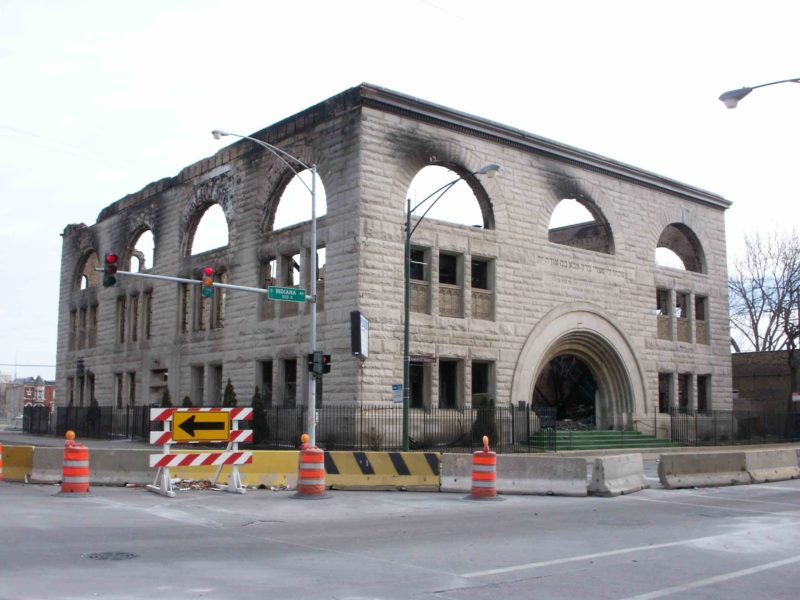(photo: The ruins of Pilgrim Baptist Church, 33rd and Indiana, Chicago (designed by Adler & Sullivan, 1890). Most of the building was destroyed in a fire on January 6, 2006. In addition to its architectural significance, it was known as the birthplace of Gospel music.)
April 16, 2019
Originally published February 2006
by Jim Peters, former Landmarks Illinois President
Although modern methods of fire detection and fighting have reduced deaths in building fires, the number of historic structures damaged by fire nationwide has remained steady—about 2,000 a year. Places of worship, with their wide-span structures, are particularly vulnerable. Channels created by balloon-frame construction in older structures provide unimpeded paths for flames, from basements to attics.
“The question,” Colonial Williamsburg’s security director told Preservation magazine (“Up In Smoke,” Nov./Dec. 2002), “is not will an old building catch fire, but when.”
Unfortunately for historic buildings, fires often take place during and immediately after rehabilitation. Welding and cutting operations, plumbing torches, tar kettles, temporary heating equipment and wiring can serve as ignition sources that can create rapid-developing fire situations, notes the National Fire Protection Association (Code for Fire Protection in Historic Structures; NFPA 914).
Nearly 50 percent of fires in cultural resources are caused by heat plates and torches, while arson is the source of 30 percent. “I shudder when I see people using torches on these old buildings,” the fire chief of Madison, Ind. told Preservation magazine. “Combine flame and aged wood, and the wood’s going to go.”
The Best Practices Manual used by the National Trust for Historic Preservation for its historic sites recommends that all “hot work” operations be done on the ground at a safe distance away from the building. If work must be done within or on the building, the owner’s permission must be granted in writing and a fire watchman—armed with an extinguisher—must be stationed during the work and for two hours after. “Open flame devices are prohibited for paint removal” and heat guns are banned unless absolutely necessary.
Planning of the construction phase, the NFPA suggests, should include discussions with the owner, architect, the contractors and project manager about fire safety. A person should be designated to represent the owner’s interest in making sure that fire safety precautions are practiced on the job site. All cutting and welding operations should require a permit under the supervision of that designee. Torch-applied roofing is an especially hazardous construction process, calling for extreme caution.
“All roof openings, vents, and other crevices should be covered with a stable, noncombustible cover to prevent the ignition of building contents,” NFPA recommends. All roof areas under repair should be checked for hot spots and signs of smoldering, with special attention to flashings and areas around all penetrations. All roofing operations involving heat sources and hot processes shall be conducted by a qualified agency.
The French Heritage Society has initiated a fundraising effort for Notre Dame.
Donate Here

